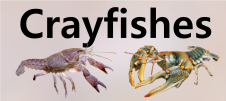






Loading profile. Please wait . . .
Procambarus hayi (Faxon, 1884)
Straightedge Crayfish




Federal Protection: No US federal protection
State Protection: No Georgia state protection
Global Rank: G5
State Rank: SNA
Element Locations Tracked in Biotics: No
SWAP 2015 Species of Greatest Conservation Need (SGCN): No
SWAP 2025 Species of Greatest Conservation Need (SGCN): No
2025 SGCN Priority Tier: None
Element Occurrences (EOs) in Georgia: 1
Habitat Summary for element in Georgia: Georgia habitat information not available
The dorsal surface of the carapace is light to dark brown with dark irregular speckles and splotches. There are dark stripes on the upper sides. Below the stripes, the carapace is pinkish brownish. There is a wide, dark stripe down the center of the abdomen bordered by pinkish stripes which are in turn bordered by thin dark lines. The claws can be quite large in males and are covered with dark tubercles; however, they look rather thin and fragile. The areola is fairly narrow and the rostrum tapers and has marginal spines or tubercles. A single cervical tubercle is usually present and may be a sharp spine on juveniles. This species reaches a maximum total body length of about 75 mm (3 in).
The only other Procambarus species that could occur with the Straightedge Crayfish are the White Tubercled Crayfish (P. spiculifer) and Black Mottled Crayfish (P. enoplosternum). White Tubercled Crayfish has white tubercles on the claws (rather than dark) and has two cervical spines on either side of the carapace as opposed to one. The Black Mottled Crayfish has a dark saddle at the rear of the carapace and usually two discrete spots along the upper sides rather than stripes.
This species can be found in sluggish streams or lentic situations as well temporary habitats like roadside ditches. It has also been collected from simple burrows in ditches and in other wet areas near streams or ponds.
Crayfishes are considered opportunistic omnivores and likely feed on live and decaying vegetation, aquatic insect larvae, small fishes, and dead animal matter.
Crayfishes that inhabit open water typically hide during the day and come out at night to feed. Reproduction usually occurs during the spring and fall, but males in reproductive condition may be found at any time during the year. When female crayfish are ready to lay eggs, they usually find a secure hiding place and hence are rarely encountered. When the eggs are released, the female attaches them to her swimmerets and is said to be “in berry.” Upon hatching, the juvenile crayfish are attached to the mother by a thread. After the juveniles molt for the second time, they are free of the mother, but stay close and will hold on to her for some time. Eventually they move off on their own. Crayfishes molt 6 or 7 times during their first year of life and most are probably able to reproduce by the end of that year. Payne (1972) studied the species in Mississippi and found that it bred in spring and summer and eggs were released by females in late summer and fall.
Since this species is found in a variety of habitats, using a seine or dipnet in streams and/or ponds can yield the species. Excavating burrows adjacent to temporary habitats or stream margins may also produce this species.
The Straightedge Crayfish is native to the Tombigbee and Tallahatchie river systems in Alabama and Mississippi and the Hatchie River system in Tennessee (Hobbs 1989). In Georgia it has been collected in tributaries to the Oconee River in Newton and Morgan counties.
Since this species is not native to Georgia, no threats are recognized.
This species is not native to Georgia and should be considered invasive.
Since this species is not native to Georgia, no conservation measures are warranted. If individuals are found, they should be humanely euthanized by freezing.
Hobbs, H.H., Jr. 1989. An illustrated checklist of the American crayfishes (Decapoda: Astacidae, Cambaridae, and Parastacidae). Smithsonian Contributions to Zoology 480:1–236.
Payne, J.F. 1972. Life history of Procambarus hayi. American Midland Naturalist 87:25-35.
Taylor, C.A., G.A. Schuster, J.E. Cooper, R.J. DiStefano, A.G. Eversole, P. Hamr, H.H. Hobbs III, H.W. Robison, C.E. Skelton, and R.F. Thoma. 2007. A reassessment of the conservation status of crayfishes of the United States and Canada after 10+ years of increased awareness. Fisheries 32:372–389.
Christopher E. Skelton
C. Skelton, October 2012: original account
C. Skelton, March 2019: general update of account.
D.Weiler, October 2019: photo added